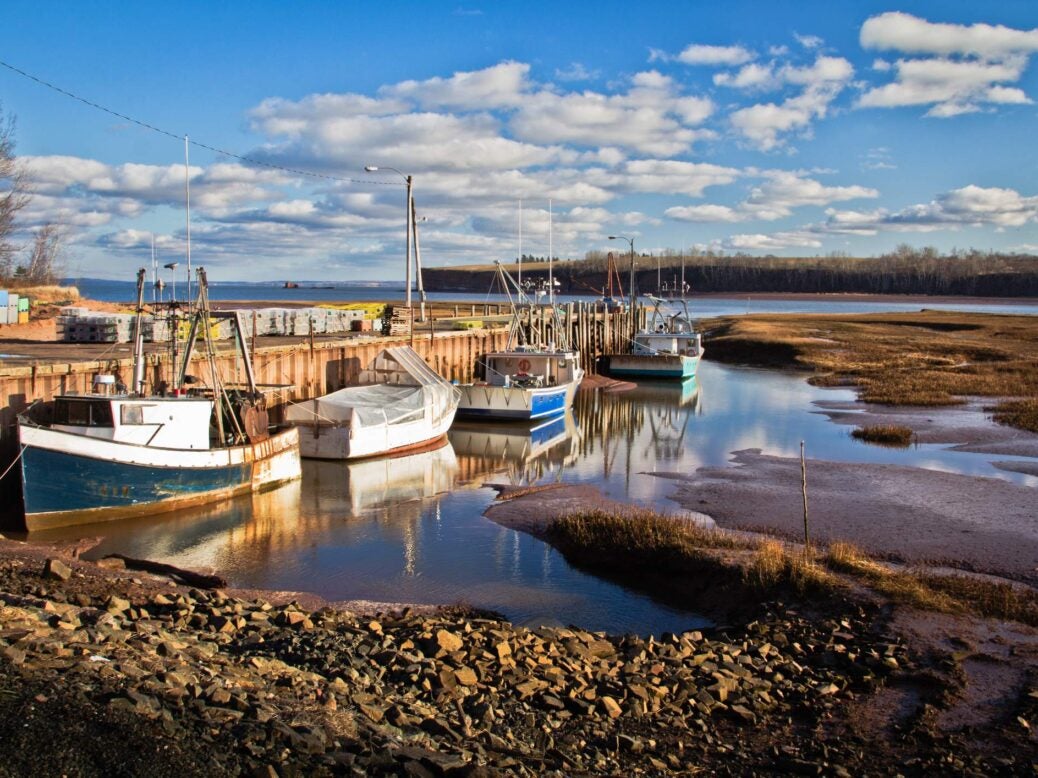
From fine wining and dining on the bed of the ocean to fishing for rare sturgeon, Canada’s Atlantic coast has a unique appeal, writes Teresa Levonian Cole
I was on the beach, chewing the ocean. It had the texture of a day-old newspaper whose pages had been compacted with damp, and the colour of Homer’s wine-dark sea. Called dulse, a seaweed harvested for millennia in the waters off Canada’s Grand Manan island, its gamey, pungent pong of iodine is such as to resurrect the dead. Worth considering, if you’re planning a trip to Chernobyl: dulse, apparently, helps protect against radiation uptake.
The rest of our picnic, foraged from local shops, was more orthodox. A spread of local lobster and scallops (purchased from a curmudgeonly, greybeard loon of a fisherman); fresh-baked, still-warm ‘St John’s bread’; smoked sturgeon pâté; a bottle of crisp white wine in an improvised ice bucket – and a 125g tin of caviar, courtesy of a wild Atlantic sturgeon.
That morning, my guide and I had taken the ferry from the New Brunswick mainland to Grand Manan, through a fog so thick that – from the island’s Swallowtail lighthouse, fog-horn booming a low, ghostly, 20-second warning – only the funnels of our returning vessel could be seen floating above the spectral whiteness before disappearing into the gloom. From below, another eerie sound rose through the 20-second gap. ‘Minke whales,’ explained the lighthouse keeper. ‘They’ve been swimming so close to shore this year, their singing’s been keeping islanders awake at night.’
But as the fog lifted with the rising sun, colour flowed into the blanched canvas to reveal blues, greens, pinks and yellows of Impressionistic luminescence. The whales became visible, along with grey seals loitering hopefully around the herring weirs. Some of the island’s 240 bird species made their twittering appearance. Surrounded by such natural beauty, a picnic seemed to be de rigueur.
Dulse, aka palmaria palmata, formed part of my gustatory exploration of Atlantic Canada – more specifically, the coast around the Bay of Fundy, whose beautiful and remote outdoors yields the freshest, most abundant and delicious flora and fauna destined for the human palate. Even humble dulse – well known to the Irish as ‘poor man’s food’ – has been reborn as a super-food, shipped worldwide in soft and crispy varieties. Rich in iron and micronutrients, it is now found in fancy health-food shops for around £90 a pound.
Dulse, of course, is not the only food yielded by the ocean to have been elevated from its humble origins. When the Bay of Fundy’s huge tide retreats, a drive across the bumpy flats from St Andrews to Minister’s Island reveals a platoon of posteriors pointing heavenward, their owners bent double in the act of excavating clams. Or take lobster, for which Atlantic Canada is famed: it is so common here that it used to be fed to prisoners and indentured labourers. They, poor fools, saw it as punishment – their grievance resulting in a court ruling that they must be served lobster no more than three times a week. I tried it sitting on the terrace of the Caves, a famous lobster shack in St Martins, watching the setting sun burnish the surrounding cliffs with an orange glow. The simple life doesn’t get much better than this.
Or so I thought. A few days later, I was floating on the lower St John river, this time, bathed in the flavescent light and psychedelic streaks of dawn – though it was not necessarily my host Cornel’s joyful rendition of ‘Like a sturgeon… Caught for the very first time’ to the tune of Madonna’s assonant hit that made my day. Together with fisherman Billy, we were hauling up a net, its floats weighed down by the promise of fish. Heave ho, and there it was: my very first sturgeon! Relatively small, at around 100lb (Atlantic sturgeon can grow to six times that size), some 22 years old. Fish number 186742.

Cornel had, evidently, met this fish before, and tagged him. We pulled him aboard, and measured him: 78in from head to tip of tail. Then Cornel turned the fish on its back, and took a biopsy. Whereupon we learnt that he was in fact a she. ‘The eggs are still too small,’ said Cornel. ‘They need another few months to mature. We should throw her back.’
And here’s the thing: Cornel Ceapa – PhD in sturgeon biology, scientist, owner and producer of Acadian Sturgeon and Caviar – is one of the only people in the world (maybe the only person) legally making caviar from a quota of sustainable, wild-caught sturgeon. In a process that takes around two hours, he harvests the entire wild Atlantic sturgeon – from its eggs to its gas bladder, used to make isinglass destined for winemakers and picture restorers. Through aquaculture, he also breeds and supplies this fish to the governments of Poland, Germany and the Baltic states.
‘We are breeding both Atlantic and shortnose sturgeon, which it is forbidden to catch,’ he tells me. ‘Unlike many other companies, we use neither hormones nor borax to harden the eggs and preserve them. The aquaculture process mimics nature as closely as possible.’
Meantime our fish, which I have nicknamed Madonna, is thrown back into the water but seems reluctant to swim away. She has beautiful skin, five rows of diamond-shaped scutes – her exoskeleton – which, alone, can sell for C$2,000 (around £1,100). Cornel is licensed to catch no more than 350 of these fish a year.
We repair to a small house – Cornel’s ‘factory’ – for a caviar tasting, accompanied by ice-cold Stolichnaya and local Mott’s Landing Brut. I am excited to be one of the first people
to taste caviar from aquacultured shortnose sturgeon. I take a dollop of its golden eggs with a pearl spoon and place it on the back of my hand. It tastes creamy, and not unlike Sevruga. The taste of the wild Atlantic caviar – its eggs darker, smaller – is more complex, and keeps growing. It commands reverence. And I give silent thanks to this noble fish, so delicious and rich in healthy omega-3s, and fear the craving it has inspired. Cornel plies me with tins of black gold, just in case of cold turkey.
My wilderness experiences alternated with fine dining in restaurants: in St Andrews, for example, a lunchtime feast, of foie gras, oysters, and scallops, courtesy of rising chef Alex Haun, at Savour in the Garden; dinner of more oysters and more lobster, followed by berry and bee-balm sabayon, at the wonderful Rossmount Inn. All this in a single day.
Never mind the ferry: I could have rolled like a barrel to my next port of call, across the Bay of Fundy to Digby, Nova Scotia. Thence I drove east, through the fertile Annapolis Valley, where I encountered unfamiliar grape varieties (viz Geisenheim 318 and Lucie Kuhlmann), and tasted Nova Scotia’s only appellation contrôlée wine: fish-friendly Tidal Bay.
But my destination lay near the bay’s south-eastern tip, at Burntcoat Head. This is where chef Chris Velden, of the Flying Apron Inn and Cookery, in partnership with award-winning Avondale Sky Winery and Meander River Brewery, performs a logistical miracle. The Bay of Fundy, with the highest recorded tides in the world, offers a rare opportunity, when the time and the tide are right, of dinner on the ocean floor.
It followed a foraging expedition with Jonathan Newell. Who’d have thought the roadside could yield foods (chicory), that you could eat Queen Anne’s Lace (a carrot-like root), that you can stuff a flower (day lily), or eat what is underfoot (wild strawberries)? Not to mention the sea rocket, sea blight, sea spinach, sea lettuce or glasswort we found on the beach, and which found their way into dinner: into the ‘Shore boil’ of lobster, mussels and clams, on which 18 of us feasted, atop the cliffs, before descending for the last three courses, to a long table laid for us on the seabed.
The ocean had retreated to reveal a vast expanse of land, and a cave beneath a tall, tree-topped mountain which a few hours earlier had been an island. We sat to enjoy dinner of freshest local fare – and, yes, more lobster. Everything had to be brought down the cliff, then hauled back up again, before 160 billion tons of water flooded back into the bay at the rate of an inch a minute.

Watching the ocean return to this remote Atlantic shore while sipping the aptly named Tidal Bay was, simply, magical. Conversation ground to a halt. The crepuscular sun danced on the water, reflecting the drama of the lowering sky. And for a moment, the scene turned silver, land and water indivisible in the mercurial light.
Teresa Levonian Cole was a guest of New Brunswick Tourism (tourismnewbrunswick.ca) and Nova Scotia Tourism (novascotia.com)











